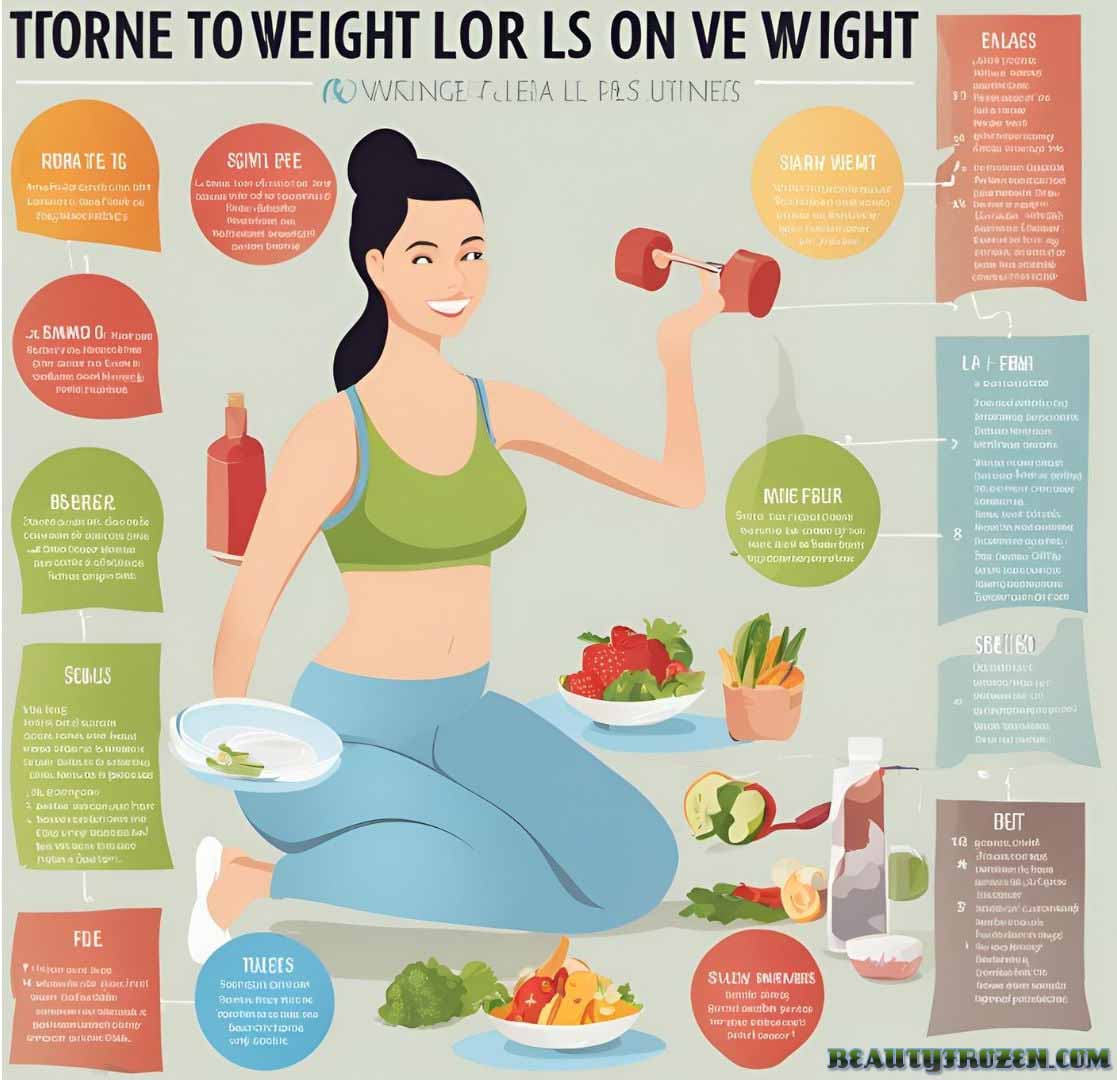Weight loss is a journey that many embark on, but few find easy. It requires dedication, the right knowledge, and a sustainable approach. In this guide, we will explore various aspects of weight loss, including quick and healthy meal prep ideas, ways to stay motivated, and the best exercises for burning belly fat. By the end, you’ll have a well-rounded understanding of how to tackle weight loss effectively.
Table of Contents
What Are Some Quick and Healthy Meal Prep Ideas for Weight Loss?
Meal prepping is an excellent way to ensure you stay on track with your weight loss goals. It saves time, reduces the temptation to opt for unhealthy options, and helps manage portion sizes. Here are some quick and healthy meal prep ideas:
Breakfast Ideas
- Overnight Oats: Combine oats, chia seeds, almond milk, and a touch of honey in a jar. Top with fresh berries and refrigerate overnight. In the morning, you have a nutritious, ready-to-eat breakfast.
- Egg Muffins: Whisk together eggs, spinach, cherry tomatoes, and a sprinkle of cheese. Pour the mixture into a muffin tin and bake. These can be stored in the fridge and reheated for a quick breakfast.
- Greek Yogurt Parfait: Layer Greek yogurt with granola and mixed fruits in a container. This can be made in bulk and stored in the fridge for a few days.
Lunch Ideas
- Quinoa Salad: Cook quinoa and mix it with chopped vegetables, black beans, corn, and a light vinaigrette. This salad is high in protein and fiber, making it filling and nutritious.
- Chicken and Veggie Stir-fry: Sauté chicken breast strips with various colorful vegetables. Add a splash of low-sodium soy sauce or teriyaki sauce for flavor. Pair with brown rice for a complete meal.
- Mason Jar Salads: Layer your favorite salad ingredients in a mason jar, starting with the dressing at the bottom and ending with the greens on top. Shake it up when ready to eat.
Dinner Ideas
- Baked Salmon and Asparagus: Place salmon fillets and spears on a baking sheet. Drizzle with olive oil, sprinkle with salt, pepper, lemon juice, and bake. Serve with a side of quinoa or brown rice.
- Turkey Chili: Brown ground turkey in a pot, then add diced tomatoes, beans, corn, and chili seasoning. Let it simmer to develop the flavors. This can be portioned out and frozen for later meals.
- Stuffed Bell Peppers: Hollow out bell peppers and stuff them with a mixture of lean ground beef, quinoa, and vegetables. Bake until the peppers are tender.
Snack Ideas
- Veggie Sticks and Hummus: Cut up carrots, cucumbers, and bell peppers to dip in hummus. This snack is low in calories and high in nutrients.
- Fruit and Nut Mix: Combine your favorite dried fruits with unsalted nuts. Be mindful of portions, as nuts are calorie-dense.
- Greek Yogurt with Honey and Almonds: A small bowl of Greek yogurt drizzled with honey and topped with a handful of almonds makes for a satisfying snack.
Meal prepping these healthy options ensures you have nutritious choices readily available, making it easier to stick to your weight loss plan.

How Can I Stay Motivated on My Weight Loss Journey?
Staying motivated during a weight loss journey can be challenging, especially when progress seems slow or obstacles arise. Here are some strategies to help you maintain motivation:
Set Realistic Goals
Setting achievable and realistic goals is crucial. Break down your weight loss journey into smaller milestones rather than focusing solely on the end goal. Celebrate each small victory to stay motivated.
Keep a Journal
Documenting your progress can provide a visual representation of your achievements. Include details about your meals, workouts, and how you feel both physically and emotionally. Reflecting on this journal can be encouraging when motivation wanes.
Find a Support System
Surround yourself with supportive friends, family, or a weight loss group. Having someone to share your journey with can provide encouragement, accountability, and a sense of community.
Reward Yourself
Set up a reward system for reaching milestones. Rewards don’t have to be food-related; they can be a new workout outfit, a massage, or a fun activity you enjoy. These incentives can keep you motivated to continue.
Focus on Non-Scale Victories
While the scale is one measure of progress, it’s not the only one. Pay attention to how your clothes fit, your energy levels, your strength, and other improvements in your health and well-being. These non-scale victories can be highly motivating.
Stay Positive
A positive mindset is essential for long-term success. Instead of focusing on what you can’t have, think about all the delicious, healthy foods you can enjoy. Practice self-compassion and be kind to yourself on this journey.
Visualize Your Success
Spend a few minutes each day visualizing your success. Imagine how you’ll look and feel once you reach your goals. This mental practice can reinforce your commitment and keep you focused.
Mix Up Your Routine
Variety can prevent boredom and keep you engaged. Try new recipes, different workouts, or change your routine to keep things interesting. This can help maintain your enthusiasm and prevent burnout.
Seek Professional Help
If you’re struggling to stay motivated, consider seeking help from a nutritionist, personal trainer, or therapist. These professionals can provide personalized guidance and support tailored to your needs.
Track Your Progress
Use apps or tools to track your progress. Seeing your progress charted out can provide a sense of accomplishment and motivate you to keep going.
Maintaining motivation is key to a successful weight loss journey. By implementing these strategies, you can stay on track and continue moving toward your goals.
What Are the Best Exercises for Burning Belly Fat?
Burning belly fat requires a combination of cardiovascular exercises, strength training, and a healthy diet. Here are some of the best exercises to help you target belly fat effectively:
Cardiovascular Exercises
- Running or Jogging: Running is a high-intensity exercise that can help burn a significant number of calories. It engages multiple muscle groups and boosts your metabolism, aiding in fat loss.
- Cycling: Whether on a stationary bike or cycling outdoors, this exercise is great for burning calories and improving cardiovascular health. It primarily targets the lower body but also engages the core.
- Swimming: Swimming is a full-body workout that combines cardio with resistance training. It’s especially beneficial for those with joint issues as it’s low-impact.
- HIIT (High-Intensity Interval Training): HIIT involves short bursts of intense exercise followed by rest or low-intensity periods. This type of workout can be very effective in burning fat and improving overall fitness.
Strength Training
- Weightlifting: Lifting weights helps build muscle mass, which in turn boosts your metabolism. Focus on compound movements like squats, deadlifts, and bench presses that work for multiple muscle groups.
- Bodyweight Exercises: Exercises such as push-ups, pull-ups, and planks can be done anywhere and are effective for building strength and burning fat. Planks, in particular, engage the core muscles.
- Resistance Bands: Using resistance bands can add variety to your strength training routine. They are portable and can provide resistance for exercises targeting different muscle groups.
Core Exercises
- Crunches: Traditional crunches target the abdominal muscles. For variation, try bicycle crunches or reverse crunches to engage different areas of the core.
- Leg Raises: Lying on your back, lift your legs to work the lower abdominal muscles. Keep your movements controlled to maximize the benefits.
- Russian Twists: Sitting with your legs bent and feet off the ground, twist your torso from side to side, holding a weight or medicine ball. This exercise targets the obliques.
- Mountain Climbers: This is a dynamic exercise that works the core and provides a cardiovascular workout. Start in a plank position and alternate bringing your knees to your chest quickly.
Full-Body Exercises
- Burpees: Burpees combine squats, push-ups, and jumps, making them a highly effective full-body workout. They elevate your heart rate and engage multiple muscle groups.
- Rowing: Rowing machines provide a full-body workout that can help burn calories and strengthen muscles. It’s a low-impact exercise that’s gentle on the joints.
- Kettlebell Swings: This exercise works the hips, glutes, and core. It’s an excellent way to burn calories and build strength simultaneously.
Incorporating Exercise into Your Routine
For optimal results, combine different types of exercises and vary your routine. Aim for at least 150 minutes of moderate aerobic activity or 75 minutes of vigorous activity each week, along with strength training exercises twice a week.
Importance of Diet
Exercise alone is not enough to burn belly fat. A healthy, balanced diet is crucial. Focus on whole foods, reduce sugar and processed foods, and ensure you’re in a calorie deficit to lose weight effectively.
Burning belly fat takes time and consistent effort. By incorporating these exercises into your routine and maintaining a healthy diet, you can achieve your weight loss goals.

How can I reduce stress to aid in weight loss?
Stress can significantly impact weight loss efforts. High-stress levels can lead to emotional eating, poor food choices, and increased cortisol production, which can promote fat storage, especially around the midsection. Here are some strategies to reduce stress and support your weight loss journey:
Practice Mindfulness and Meditation
Mindfulness techniques and meditation can help reduce stress and improve your relationship with food. Even just 10 minutes of meditation daily can make a difference.
Get Adequate Sleep
Poor sleep is linked to increased stress and weight gain. Aim for 7-9 hours of quality sleep each night. Establish a consistent sleep schedule and create a relaxing bedtime routine.
Exercise Regularly
Physical activity is a great stress reliever. It releases endorphins, which are natural mood boosters. Find activities you enjoy and make them a regular part of your routine.
Practice Deep Breathing
Deep breathing exercises can activate the body’s relaxation response, reducing stress and anxiety. Try the 4-7-8 technique: inhale for 4 counts, hold for 7, and exhale for 8.
Connect with Others
Social support can significantly reduce stress. Spend time with friends and family, join support groups, or consider talking to a therapist if stress is overwhelming.
Time Management
Poor time management can lead to increased stress. Use tools like calendars and to-do lists to organize your tasks and reduce feelings of being overwhelmed.
Limit Caffeine and Alcohol
While these substances might seem to help in the short term, they can increase anxiety and disrupt sleep patterns, leading to increased stress over time.
Practice Self-Care
Make time for activities you enjoy and that help you relax. This could be reading, taking a bath, practicing yoga, or engaging in a hobby.
Nature Therapy
Spending time in nature has been shown to reduce stress levels. Try to incorporate outdoor activities or simply spend time in green spaces regularly.
Cognitive Behavioral Therapy (CBT)
CBT can help you identify and change negative thought patterns that contribute to stress. This can be particularly helpful if stress is significantly impacting your weight loss efforts. By incorporating these stress-reduction techniques into your daily routine, you can create a more conducive environment for weight loss, both physically and mentally.
What are some common mistakes people make when trying to lose weight?
While the intention to lose weight is commendable, many people fall into common traps that can hinder their progress. Recognizing these mistakes can help you avoid them and increase your chances of success. Here are some of the most common pitfalls:
Crash Dieting
Drastically cutting calories might lead to quick initial weight loss, but it’s often unsustainable and can slow down your metabolism. Instead, aim for a moderate calorie deficit that allows for steady, sustainable weight loss.
Neglecting Strength Training
Many people focus solely on cardio for weight loss, neglecting strength training. Building muscle through resistance exercises can boost your metabolism and help you burn more calories even at rest.
Overestimating Calories Burned During Exercise
It’s easy to overestimate how many calories you burn during exercise, which can lead to overeating. Use a heart rate monitor or fitness tracker for more accurate estimates, and don’t use exercise as an excuse to overindulge.
Underestimating Calorie Intake
People often underestimate how much they eat, especially when it comes to snacks and beverages. Use measuring tools and food-tracking apps to get a more accurate picture of your calorie intake.
Focusing on the Scale Too Much
Weight can fluctuate due to factors like water retention, muscle gain, and hormonal changes. Don’t get discouraged by daily weight fluctuations. Instead, focus on long-term trends and other measures of progress like how your clothes fit or body measurements.
Neglecting Sleep
Poor sleep can disrupt hormones that regulate hunger and fullness, leading to increased appetite and cravings. Prioritize getting 7-9 hours of quality sleep each night.
Drinking Calories
Beverages like sodas, juices, and alcoholic drinks can add a significant amount of calories to your diet without providing much satiety. Focus on water, unsweetened tea, and other low-calorie beverages.
Not Planning for Setbacks
Weight loss isn’t always linear. There will be ups and downs, and it’s important to have strategies in place for dealing with setbacks. Don’t let one bad day or week derail your entire efforts.
Ignoring Portion Sizes
Even healthy foods can contribute to weight gain if consumed in large quantities. Learn about appropriate portion sizes and use tools like measuring cups or a food scale when necessary.
Following Fad Diets
Fad diets often promise quick results but are usually unsustainable and can be nutritionally imbalanced. Instead, focus on making long-term, sustainable changes to your eating habits.
Not Reading Food Labels
Many “healthy” foods are high in calories, sugar, or unhealthy fats. Learn to read and understand nutrition labels to make informed choices.
Skipping Meals
Skipping meals, especially breakfast, can lead to overeating later in the day. Aim for regular, balanced meals to keep your metabolism steady and prevent excessive hunger.
Emotional Eating
Using food to cope with emotions can sabotage weight loss efforts. Find alternative ways to deal with stress, boredom, or other emotions that trigger eating.
Not Eating Enough Protein
Protein is crucial for maintaining muscle mass during weight loss and can help you feel fuller for longer. Make sure you’re including adequate protein in your diet.
Expecting Quick Results
Sustainable weight loss takes time. Setting unrealistic expectations can lead to disappointment and giving up. Aim for a healthy rate of 1-2 pounds per week. By avoiding these common mistakes and focusing on sustainable, healthy habits, you can increase your chances of successful, long-term weight loss.
Conclusion
Weight loss is a multifaceted journey that involves a combination of healthy eating, regular exercise, and staying motivated. By preparing quick and healthy meals, setting realistic goals, and incorporating effective exercises into your routine, you can achieve and maintain your weight loss goals. Remember, the key to success is consistency and making sustainable changes that you can stick with in the long run. Stay positive, stay committed, and enjoy the process of
